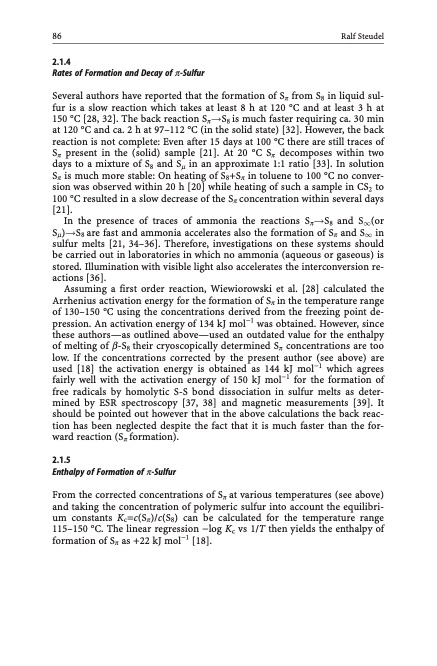
PDF Publication Title:
Text from PDF Page: 096
86 Ralf Steudel 2.1.4 Rates of Formation and Decay of p-Sulfur Several authors have reported that the formation of Sp from S8 in liquid sul- fur is a slow reaction which takes at least 8 h at 120 C and at least 3 h at 150 C [28, 32]. The back reaction Sp!S8 is much faster requiring ca. 30 min at 120 C and ca. 2 h at 97–112 C (in the solid state) [32]. However, the back reaction is not complete: Even after 15 days at 100 C there are still traces of Sp present in the (solid) sample [21]. At 20 C Sp decomposes within two days to a mixture of S8 and Sm in an approximate 1:1 ratio [33]. In solution Sp is much more stable: On heating of S8+Sp in toluene to 100 C no conver- sion was observed within 20 h [20] while heating of such a sample in CS2 to 100 C resulted in a slow decrease of the Sp concentration within several days [21]. In the presence of traces of ammonia the reactions Sp!S8 and S1(or Sm)!S8 are fast and ammonia accelerates also the formation of Sp and S1 in sulfur melts [21, 34–36]. Therefore, investigations on these systems should be carried out in laboratories in which no ammonia (aqueous or gaseous) is stored. Illumination with visible light also accelerates the interconversion re- actions [36]. Assuming a first order reaction, Wiewiorowski et al. [28] calculated the Arrhenius activation energy for the formation of Sp in the temperature range of 130–150 C using the concentrations derived from the freezing point de- pression. An activation energy of 134 kJ mol1 was obtained. However, since these authors—as outlined above—used an outdated value for the enthalpy of melting of b-S8 their cryoscopically determined Sp concentrations are too low. If the concentrations corrected by the present author (see above) are used [18] the activation energy is obtained as 144 kJ mol1 which agrees fairly well with the activation energy of 150 kJ mol1 for the formation of free radicals by homolytic S-S bond dissociation in sulfur melts as deter- mined by ESR spectroscopy [37, 38] and magnetic measurements [39]. It should be pointed out however that in the above calculations the back reac- tion has been neglected despite the fact that it is much faster than the for- ward reaction (Sp formation). 2.1.5 Enthalpy of Formation of p-Sulfur From the corrected concentrations of Sp at various temperatures (see above) and taking the concentration of polymeric sulfur into account the equilibri- um constants Kc=c(Sp)/c(S8) can be calculated for the temperature range 115–150 C. The linear regression log Kc vs 1/T then yields the enthalpy of formation of Sp as +22 kJ mol1 [18].PDF Image | Topics in Current Chemistry

PDF Search Title:
Topics in Current ChemistryOriginal File Name Searched:
Elemental-Sulfur-und-Sulfur-Rich-Compounds-I.pdfDIY PDF Search: Google It | Yahoo | Bing
Sulfur Deposition on Carbon Nanofibers using Supercritical CO2 Sulfur Deposition on Carbon Nanofibers using Supercritical CO2. Gamma sulfur also known as mother of pearl sulfur and nacreous sulfur... More Info
CO2 Organic Rankine Cycle Experimenter Platform The supercritical CO2 phase change system is both a heat pump and organic rankine cycle which can be used for those purposes and as a supercritical extractor for advanced subcritical and supercritical extraction technology. Uses include producing nanoparticles, precious metal CO2 extraction, lithium battery recycling, and other applications... More Info
| CONTACT TEL: 608-238-6001 Email: greg@infinityturbine.com | RSS | AMP |